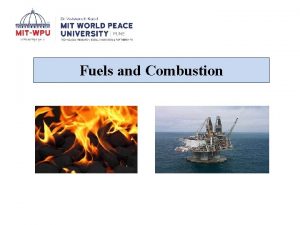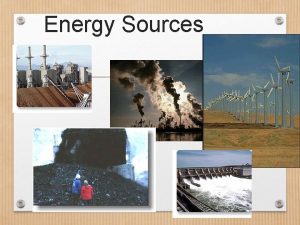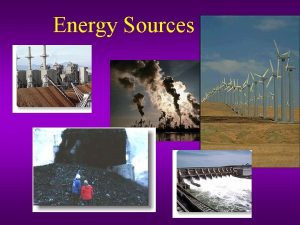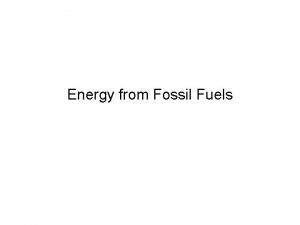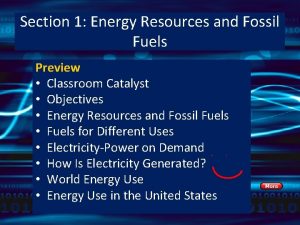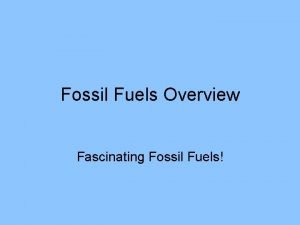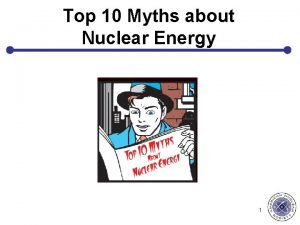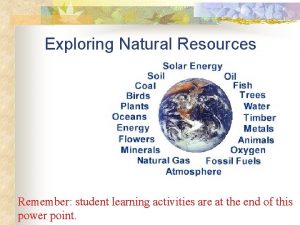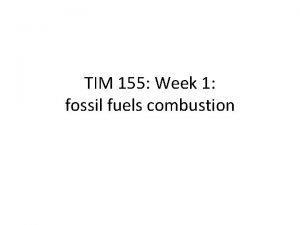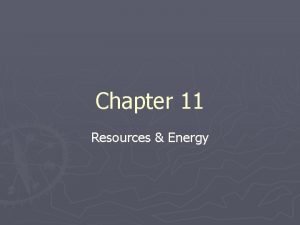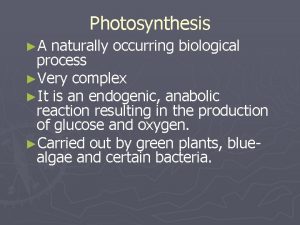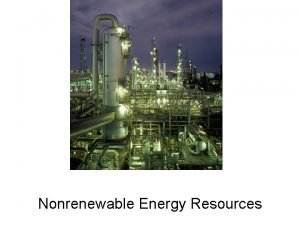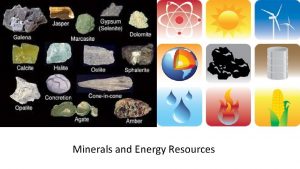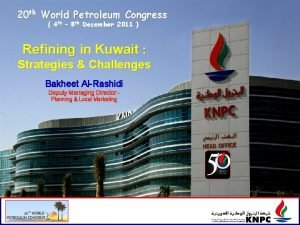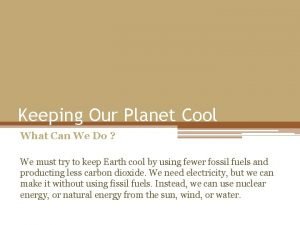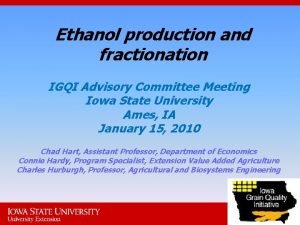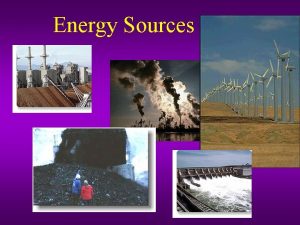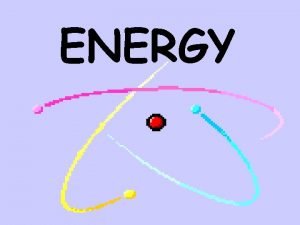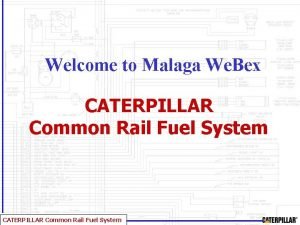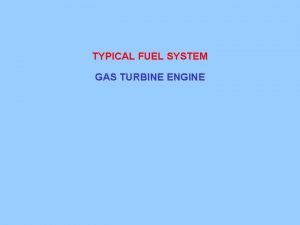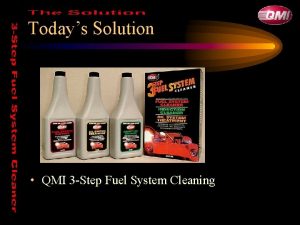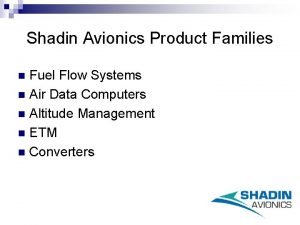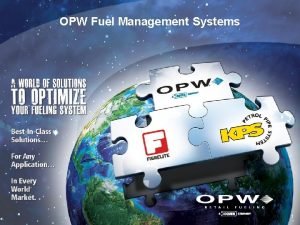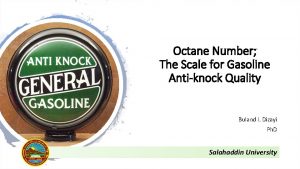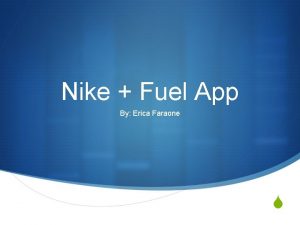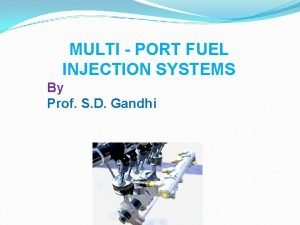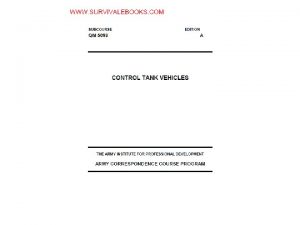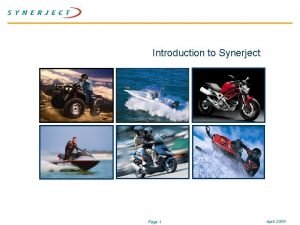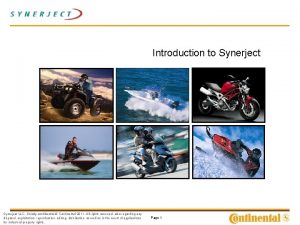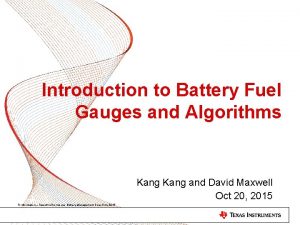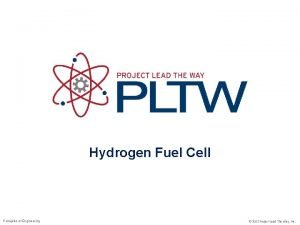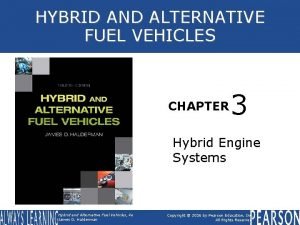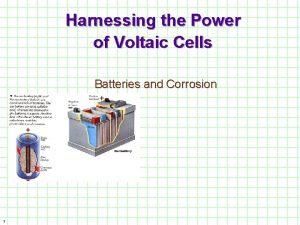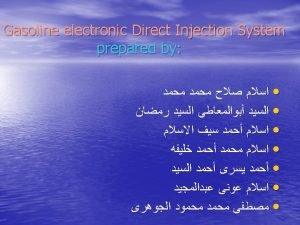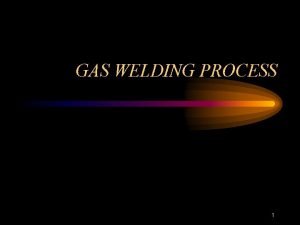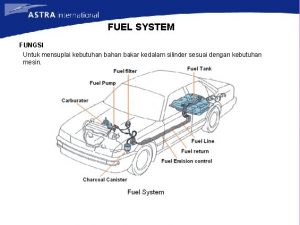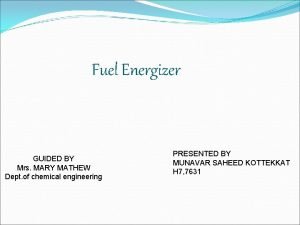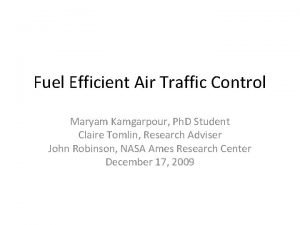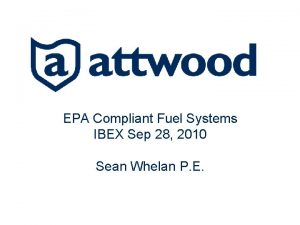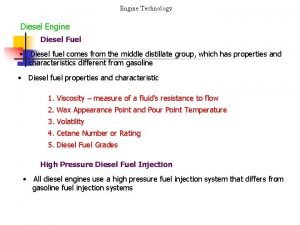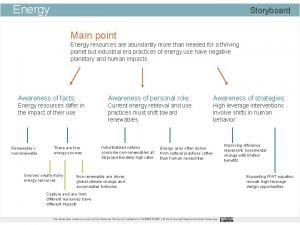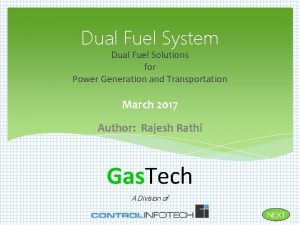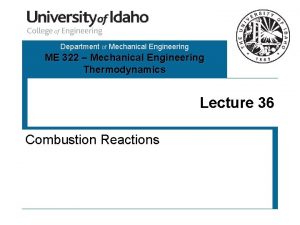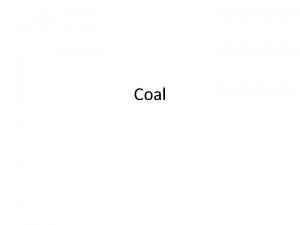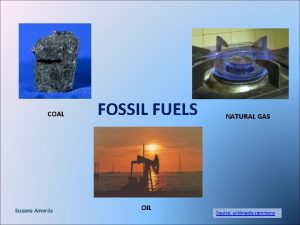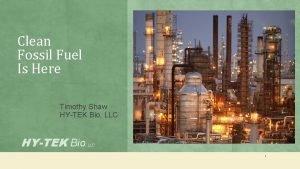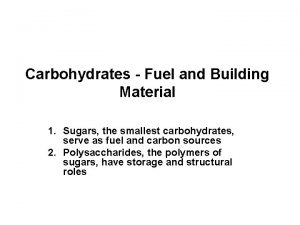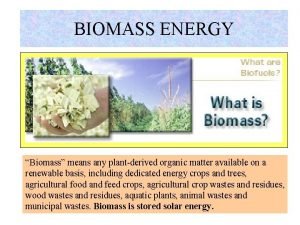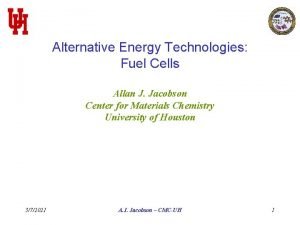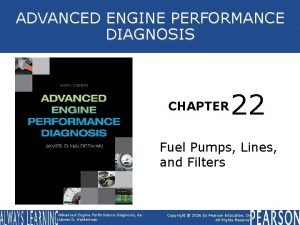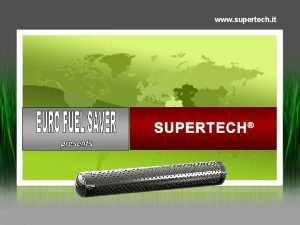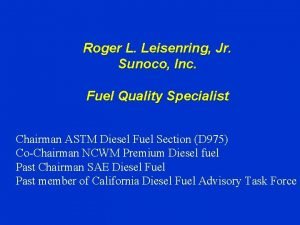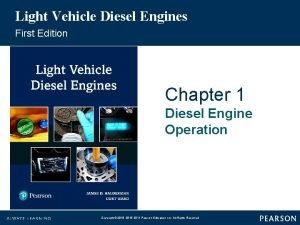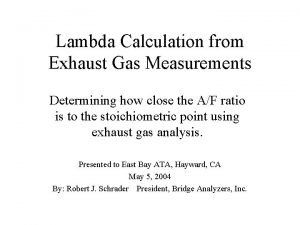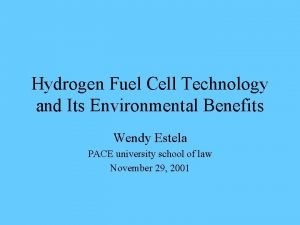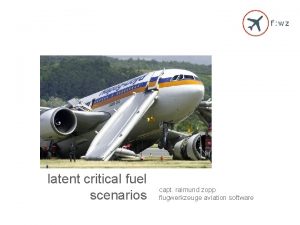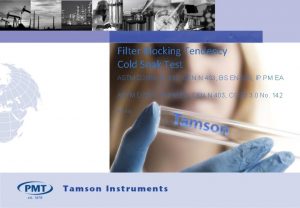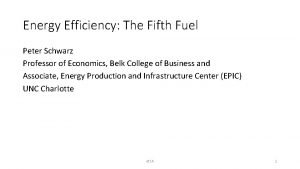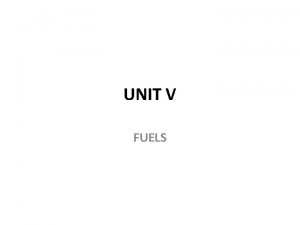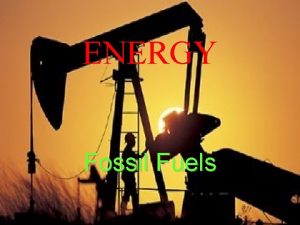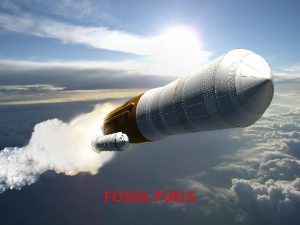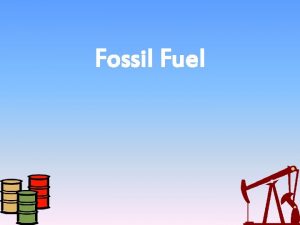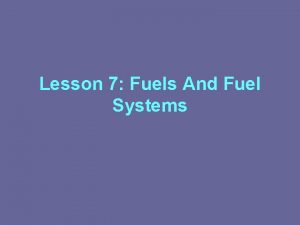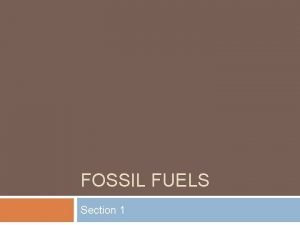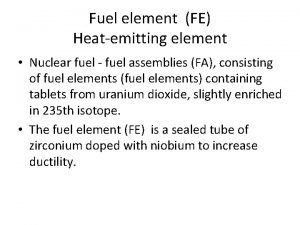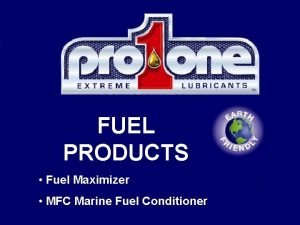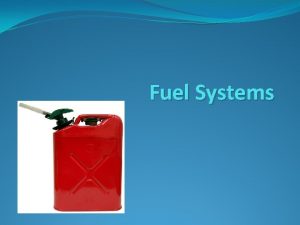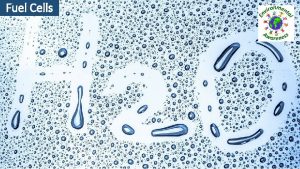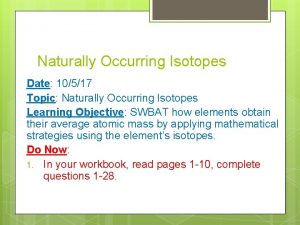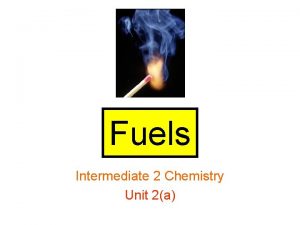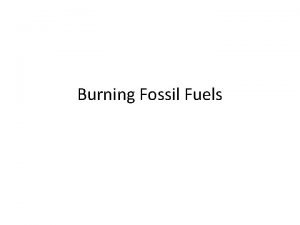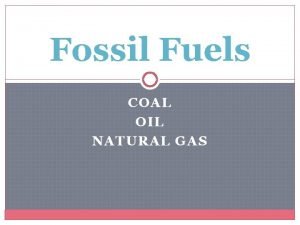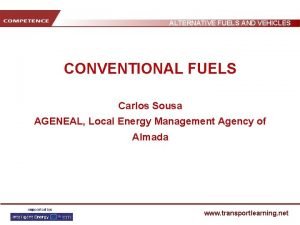UNIT V FUELS Fuels are naturally occurringfossil fuel
























































































- Slides: 88

UNIT V FUELS

• Fuels are naturally occurring(fossil fuel) or artificially manufactured combustible organic substances which is a source of heat or raw material for industry. Fuel is a substance that undergoes combination with O 2 in air to liberate heat. They can be solids, liquids or gases.

• They have carbon and hydrogen. The chief fuels are coal and mineral oil. Fuels can be either of vegetable (organic- coal etc) or mineral (inorganic – sulphur, iron pyrites etc) origin, can be also nuclear, like enriched uranium oxide.

Definition 1. Defined as any source of heat energy. 2. It is a combustible substance containing carbon as main constituent which on proper burning gives large amount of heat that can be used economically for domestic and industrial purposes. 3. It is any chemical or any reactant which produces energy in a form that can be used for producing power.

Classification Fuels are classified as follows I: Solid, liquid and gases II: i) Natural or raw fuels or primary fuels. Ex: Wood Peat, coal, petroleum ii) Manufactured or processed or artificial or secondary fuels Ex: Coke, charcoal, kerosene, petrol

III : i) Primary fuels ii) Secondary fuels Primary fuels are directly used for the function of heat and its technical utilization as such. They may be solids, liquids or gases. Ex: Coal, wood, petroleum.

• Secondary fuels are one from which other fuels are manufactured, which is then utilized as fuel. These are obtained from primary fuels. Ex Coal gas, water gas, producer gas etc are obtained from primary fuel coal.

Natural fuels: Solid Fuels Ex; Wood, peat, lignite, bituminous, anthracite coal Liquid Ex: petroleum Gaseous Natural gas from petroleum wells.

Manufactured fuels Solid: Charcoal, high and low temperature coke. Liquid Petrol or gasoline, kerosene, diesel, ethanol, methanol Gaseous: Coal gas, coke oven gas, producer gas, water gas.

Industrial fuels: I : Power generating fuels : These are burned in power plants for generating energy. II : Process fuels: These are used in industrial furnaces and driers to produce heat which is needed in various industrial processes.

Calorific value : • The amount of heat given out by different fuels will be different. This difference is compared based on calorific value. Calorific value is defined as the amount of heat produced in calories during the combustion of one gram of a substance in oxygen. Its unit is kcalg-1.

• Calorific value is measured by the number of British thermal units (BTU) liberated by the combustion of one lb of a solid fuel or one cubic feet of a gaseous fuel. 1 BTU is the amount o heat required to raise the temperature of one lb of water through 1 o. F. Calorific value can be measured using bomb calorimeter.

Flash point: • For a liquid fuel it is the temperature at which it emits vapour which is kindled by a flame. The lowest temperature, at which oil continues to burn after a flame has been applied to it, is its ignition point. Flash point of gasoline is 45 o. C, for kerosene it is 73 o. F.

Ignition temperature: • It is the temperature below which a solid fuel will not catch fire and burn.

Essential requirements of fuels: • A good fuel should have high calorific value and low moisture content. • It should be of low cost and readily available. • It should be easily transportable. • It should not give any undesirable by products during burning. • It should leave only little ash or non- combustible material. If they have large percentage of non- combustible material left as ash then the calorific value decreases.

• The combustion product of the fuel must not be harmful. • It should burn in air with efficiency without producing much smoke. • Its combustion should take place spontaneously and should be controllable. • Particle size of solid fuels should be uniform.

• It should produce high temperature, called as pyrometric burning effect. This highest temperature obtained by combustion depends upon i) calorific value ii) Velocity of combustion iii) space in which it is burnt iv) physical state of fuel. • If same quantity of solid, liquid and gaseous fuels is burnt in same amount of air, gaseous fuel gives the highest pyrometric effect, liquid less effect and solid the least.

• Fuels should have proper ignition point. If have low ignition temperature then fire hazards can happen. But high ignition temperature makes fuel safe for transportation and storage, but not favorable for starting fire. So moderate ignition temperature and moderate velocity of combustion is favored for a good fuel.

Energy characteristics of a fuel: Energy characteristics of a fuel depends on • Heat of combustion: It is the amount of heat obtained by burning a unit mass or volume of a fuel. • Energy content : It is the amount of potential heat energy contained in a unit volume of a fuel and measured as the volume of fuel in m 3 corresponding to one ton of reference fuel, whose heat of combustion is 292. 4 kj/kg(700 kcal/kg)

• Solid and liquid fuels contain organic combustible part(C, H, O) and a mineral in combustible part which is moisture and inorganic compounds like silicates, phosphates, sulphites of metals like Ca, Al, Fe, K and Na. These mineral substances are converted into metal oxides on burning of solid fuel and remaining ash.

• Sulphur as sulphides is oxidized to SO 2. Moisture and minerals lower the energy ratings of fuels, raise the cost of transportation and complicates processing technology. When fuel is heated without access of air (pyrolysis) gaseous and liquid products from that are contained as vapours in the pyrolysis products. This vapour and gas mixture also containing the fuel water is called volatile matter.

Water Gas: • Water gas is often called as blue gas since the flame formed will be blue in colour when burnt. Water gas is a mixture of CO and H 2. It is produced by passing steam over red hot bed of coke at 1400 to 1000 0 C.

H 2 O + C → CO + H 2 -29 kcal. • This is an endothermic reaction, so temperature falls from 1400 to 10000 C. At this temperature CO 2 is also formed. 2 H 2 O + C → 2 H 2 + CO 2 -19 kcal

• This CO 2 has no calorific value. Formation of water gas depends on the decomposition of steam by coke at 758 o. C, at this temperature 25. 3% steam is decomposed so the composition will be 56. 2% of H 2, 7. 8% CO and 27%CO 2. At 1000 o. C 93% stem is decomposed so the composition will be 50. 7% H 2, 48%CO and 1. 3% CO 2.

• And at 1125 o. C 99. 4% of steam is decomposed so the composition will be 50. 9%H 2, 48. 5% CO and 0. 6%CO 2. To maintain the percentage of decomposition ie at 1000 o. C or above, blast of steam is stopped and air blast is passed to raise the temperature to 1400 o. C.

• Then pass stem blast and then pass air blast and so on. Since air forms explosion with water gas, water gas is removed by passing steam for one minute, this steam is called purge steam. The average composition of water gas is 48% of H 2, 1% of CH 4, 42% of CO, 3% of CO 2 and 6% of N 2. The calorific value of water gas is about 300 Btu/cu ft.

Uses: – Used as a source of H 2 and as a reducing agent in metallurgy. – It is added to coal gas for street lighting. – Used to synthesis chemicals like alcohols and oxygenated compounds.

Producer Gas: • Producer gas is a mixture of CO and N 2. This a cheap individual fuel obtained from low grade coal. This is prepared by passing air over a bed of white hot coke or solid carbonaceous fuel at 1000 – 1400 o. C. • C + ½ O 2 + 2 N 2 (air) → CO + 2 N 2 ΔH = -27. 06 kcal

• During preparation, actually CO 2 is first produced; it then reacts with coke to give CO. Instead of coke and coal, peat, wood waste, spent tar can be used. But largely used raw material is coke and coal. Coke or anthrasite or charcoal is used if producer gas is used in gas engines for power production. It is manufactured in a plant known as “ gas producer”.

• The fuel is stacked in a grate in the cylindrical furnace, made of fire clay refractory bricks. The blast of air is blown through the grate. The fuel is fed from the top. Gas produced leaves the furnace through the gas outlet. 2 C + O 2 → 2 CO + 58000 cal C + O 2 → CO 2 +97000 cal CO 2 + C → 2 CO -39000 cal

• The CO 2 formed is reduced to CO by heated coke and as the reaction is endothermic, the temperature of the bed is kept high at above 1000 o. C. The proportion of CO increases with increase in temperature.

• Producer gas has lower calorific (1300 kcal/m 3) value of any gaseous fuel and the temperature of its flame is the lower of any fuel. Its calorific value is 150 Btu per cubic feet. Its average composition is 10% H 2, 8% CH 4, 20% CO, 4%CO 2 and 64% N 2.

Uses: • It is used for heating coal gas retorts, in furnace and gas engines.

Oil Gas: • This oil is used in labs. It is obtained by cracking heavy oil like kerosene, during which a mixture of gaseous hydrocarbons are produced. C 16 H 34 → 6 CH 4 + 2 C 2 H 4 + C 2 H 2 + 4 C • The average composition of oil gas is 25 -30% CH 4, 50 -55%H 2, 10 -12%CO and 3%CO 2. Its calorific value is 4500 -5400 kcal/m 3.

Natural gas: • This is a mixture of methane (80 - 98 %), ethane, propane, butanes, pentanes, CO 2, N 2 etc. Its calorific value is 1200 -1400 kcal/m 3. This is found in vicinity of coal mines or oil fields.

• It is used in domestic, industrial and as a chemical raw material for various syntheses. It accumulates in underground reservoirs either with out petroleum oil. Natural oils obtained from oil wells may be either wet or dry.

i) Dry Variety • This type contains mainly of methane and does not contain either gasoline vapour or crude petroleum. Its composition will be 96%CH 4, 0. 8%C 2 H 4 and 3. 2%N 2.

ii) Wet variety • This type consists of a mixture of methane and higher HC, like n-propane, n-butane. Isobutene, isopentane etc. It is obtained from oil producing wells along with petroleum. Calorific value of this variety is higher than dry variety because of its high percentage of heavier unsaturated molecules.

By products from natural gases: • The products formed like methane, propane, butane, natural gasoline and LPG are of industrial importance. These are separated from crude gas as liquids by the absorption of higher HC in petroleum or catalytically polymerizing higher HC into liquid HC. Natural gas is transported in the form of liquid.

• The gas contains undesirable compounds like H 2 O, H 2 S, which should be removed before usage. The gas obtained by fermentation of organic matter in sewage is also called sewage natural gas. The sewage is collected and subjected to anaerobic fermentation, were by the nitrogenous matter in it is converted into nitrates and a part of the carbonaceous matter is converted into sewage natural gas consisting mainly of methane and CO 2.

• This gas contains 70% methane and 30%CO 2. The calorific value of the gas is 62. 5 Btu/Cu ft.

• Cow dung is the main source of natural gas. Cow dung on fermentation gives gas with composition as in sewage gas. The residue formed in this process is used as manure. Natural gas burns with smoky flame in ordinary burners. So use special appliances.

• Natural gas can be liquefied under pressure and cooling to -121 o. C. This can be mixed with other fuels to increase their calorific value. This gas is used for the manufacture of carbon black. CH 4 natural gas used for the manufacture of formaldehyde and methanol by controlled oxidation. Helium is also recovered from natural gas.

Coal gas: • Coal gas is obtained from the destruction of coal ie when coal is heated in the absence of air. One ton of coal gives 12000 cubic feet of coal gas at 1000 o. C and the yield is 18%. The yield can be increased to 22% by increasing the temperature to 1400 -1500 o. C.

• Coal gas produced by this process is a mixture of gases and about 95% of it is combustible. The compounds present in the mixture depend on the temperature of carbonization. The average composition of the gas is 49% of H 2, 32% of CH 4, 8% of CO, 4 -5% acetylene and ethylene, 4% of N 2, 1% of O 2 and 1% of CO 2.

• H 2, CH 4 and CO are non-illuminating but heat producing, N 2, O 2 and CO 2 are inert or diluents. H 2 S, CS 2, NH 3, cyanogens etc are present as impurities. Its calorific value is about 4900 kcal/m 3.

• This gas is used to provide inert atmosphere in number of preparations, used to provide reducing atmosphere in metallurgical operations, in smelting of metals and alloys, used as fuel and illuminanent, used in producing fuel gases and in making graphite, and does not condense on cooling.

Gobar or bio gas: • This is a mixture of methane, CO 2, H 2 and H 2 S. The average composition is 55% CH 4, 7. 4% H 2, 35%CO 2, 2. 6%N 2 and traces of water. This is produced by the anaerobic fermentation of animal waste in the absence of O 2 and in the presence of H 2 O.

• The carbohydrates, proteins and fats in animal waste are broken down by bacteria to form CH 4. The residue formed during the process can be used as manure since the essential nutrients like N 2 and phosphorous remains intact.

• The gas is highly flammable and is used as fuel. Natural gas is also biogas, which results from long time decay of animal and vegetable matters brought about by bacteria’s at high temperature, high pressure etc. The average calorific value is 5300 kcal/m 3.

• The limitation of this gas is that its formation depends on cattle dung and the burner or lamp should be with in ten meters of the plant.

LPG (Liquid petroleum gas): • This is a petroleum gas obtained by the fractional distillation of petroleum, which catches fire readily. It is a mixture of butane as major part along with propane, ethane and alkenes.

• The high alkene variety of LPG contains 27% of n-butane, 25%2 -butane, 435 of butane, 2. 5% of propene and 2. 5% of propane. The low alkene variety contains 70% of butane, 18. 3% of 2 -butane, 1. 2% of butane. 11. 3% of propane and 0. 2% of ethane.

• This is prepared from natural gas or gas from the cracking units of petroleum refineries. This can be liquefied under pressure. For house hold use 14 kg of it is liquefied and bottled.

• The pressure of the gas at room temperature within the cooking cylinder is about 3 kg/cm 2 in closed condition. The pressure decreases to 0. 034 kg/cm 2 by the operation of the cylinder regulator.

• The mixture of gas has no smell so to detect leakage a strong smelling substance ethylmercaptan is added. Its calorific value is 29780 kcal/m 3.

Coal products: • Besides being used as a fuel coal is converted into a) coal gas and coke by destructive distillation b) gaseous fuels like water, producer gases etc and c) liquid fuels by hydrogenation. The destructive distillation of coal is known ad carbonization.

• Coal is carbonized at high temperature ie 1200 o. C-1400 o. C or at low temperature ie 600 o. C -650 o. C. In either case the main products are coal gas, coal tar and coke. The products formed vary in quality.

Low temperature carbonization • At low temperature process, less gas is obtained but with high calorific value. This process gives high yield of fluid tar of low viscosity with high percentage of phenol and Nitrogen compounds, high percentage of tar acids, motor spirit and fuel oil. High temperature tar is the principal source of aromatic compounds like benzene, toluene, naphthalene, anthrascene and phenol.

• Low temperature tar is converted into motor spirit and diesel oil by hydrogenation. Low temperature coke is soft and fireable, burns without smoke and contains 5 to 10 % of volatile matter. High temperature coke is hard, suitable in metallurgy and burns with smoke.

• Low temperature carbonization is done when i) low temperature semi coke as a domestic fuel is needed ii) complete gasification of coal is required iii) smoke less, free burning coke is required iv) to obtain coal tar suitable for conversion in to liquid fuels for use as motor spirit.

• In this process the yield of gas is low, quantity of tar is more and has high percentage of paraffin substance, yield of ammonia is low, aromatic content of tar is low and tar acid content is high.

High temperature carbonization • The need of this process is to manufacture coal gas and coke and several valuable by- products like coal tar, ammoniacal liquor, gas carbon and coke. Coal gas is used for heating and lighting. Coal tar on fractional distillation gives benzene, toluene, naphthalene, carbolic acid, creosote oil( used for preparing dyes, drugs, perfumes and explosives).

• Coal tar pitch is used for road making, directly used for preserving timber and for water proofing gunny bags. Ammoniacal liquor on boiling with milk of lime yields ammonia, which is fixed by H 2 SO 4 as ammonium sulphate, which is used as fertilizer. Gas carbon is hard and is a good conductor of heat and electricity. It is used in making electrodes.

Liquid fuel from coal: • Coal is pyrolysed in the presence of sulphur resisting catalyst like molybdenum, in the atmosphere of H 2 at 300 -500 o. C. At 200 -250 o. C H 2 combines with N 2 of coal to produce ammonia and with O 2 of coal to produce water.

• During this process three fractions are obtained i) crude spirit, the top fraction ii) middle oil, the middle fraction and iii) heavy oil , which is the residue. Middle oil can be converted to spirit and can be used in motors.

• Using different catalyst different hydrocarbons can be separated. The liquid fuel obtained is fractionally separated into gasoline and the higher boiling fraction is an excellent diesel fuel. Using cobalt as catalyst olefin’s and paraffin’s are produced.

Petroleum products: • Petroleum, a liquid fuel, is also called as rock oil which is obtained from the ground either by natural seepage or by drilling wells. It consists of liquid oils, hydrocarbons, natural gas, waxes, sulphur, nitrogen, and oxygen.

Formation of petroleum: • Inorganic theory - Formed by the action of steam or water on heavy metal carbides existing in the interior of the earth.

• Organic theory - Formed by the decomposition of marine organic matter deposit by bacterial action in the absence of oxygen. • It can be formed by the decomposition of organic matter deposit by the catalytic action of inorganic matter.

Composition of petroleum: • It is a mixture of major part of hydrocarbons, minor amount of naphthenic acids, Sulphur, nitrogen and oxygen derivatives of hydrocarbons. It contains 83 -87% of carbon, 11 -14 % of hydrogen and 0 -4% of S, N and O 2. The composition will be constant since only eight or nine homologous series of compounds are present.

• The hydrocarbons present are n- paraffin’s, iso -paraffin’s, olefins, napthenes, and aromatics. Next to paraffin’s napthenes are abundant and then aromatics and olefin’s. Sulphur present is a pollutant so it should be removed.

Classification of Petroleum: • The classification is based on composition of i) Paraffin base which contains hydrocarbons of paraffin series. ii) Asphaltic base which contains hydrocarbons of naphthalene ring or naphthalene product. iii) Mixed base which contains both paraffin and asphaltic base.

Products obtained from petroleum distillation: Petroleum ether - 20 -60 o. C - solvent Benzene - 70 -90 o. C - dry cleaning Ligroin - 80 -120 o. C - solvent Rubber solvent - 100 -160 o. C - rubber solvent • White spirit - 150 -200 o. C - solvent • •

• Solvent naphtha - >200 but < 300 o. C - solvent • Kerosene - >200 - <300 o. C - fuel • Lubricating oil - >300 o. C • Vaseline/grease - lubricant, medicine, cosmetics • Diesel oil (gas oil) - used in diesel engines

• Heavy fuel oil - fuel for generating heat. • Paraffin wax - candles, waxed paper, polishes. • petroleum wax - water proofing coating on metals • Petroleum jelly - cosmetics, coating metals. • Bitumen - road making, roofing, paints, coating pipes • Liquid paraffin or white oil - medicine.

Octane number of a fuel: • It is the percentage of iso-octane which must be added to n- heptanes in order to obtain a mixture which matches the knocking characteristics of the fuel under examination, in a one cylinder motor engine under standard conditions. The octane number of isooctane is 100 and for n-heptanes it is zero.

• Isooctane and other branched paraffin’s under high compression have less knocking tendency, so better fuel for modern vehicles and aero plane. Aviation gasoline has an octane number 100 and ordinary gasoline, which is a mixture of large amount of straight chain paraffin’s and small amounts of olefins, naphthenes and aromatics, has an octane number ranging from 73 to 20.

Cetane number: • The suitability of a fuel for diesel engine is expressed as cetane number. It is defined as the percentage of cetane which is to be mixed with methyl naphthalene in order to obtain a fuel which matches the performance of the fuel under examination. For diesel engines cetane is normal hexadecane.

Knocking: • Knocking is a sharp metallic sound produced in the internal combustion engine. This results in huge loss of energy in the engine.

Antiknock compounds: • These are compounds used to prevent knocking in engines. Compounds used tetraethyl lead (largely used in gasoline and petrol) and iron penta carbonyl.

Industrial gases: • Following are the gases commonly used for industrial purposes. • 1) H 2 2) O 2 3) N 2 4) CO 2 5) acetylene 6) ethylene 7) helium.

1) Hydrogen: • This is prepared by the electrolysis of water. Uses: • In the synthesis of ammonia and then converting ammonia into fertilizers. • For hydrogenating oils to make fats or in the hardening of fatty oils. • As a fuel for rockets. • For the hydrogenation of coal.

• For hydrogenating water gas to produce methanol. • For producing HCl. • In filling meteorological balloons. • As a cooling gas for alternators in place of air • In producing an inert atmosphere in making tungsten filaments for electric lambs.

Carbon dioxide: • This is obtained as a by product in the production of hydrogen by steam-water gas or during fermentation of glucose.

Uses: • Solid CO 2 is for refrigerating ice creams, meat and other foods. • Liquid CO 2 is used for blasting coal. • The gas is used for preparing aerated water.

Acetylene: • This is prepared by the reaction of calcium carbide with water. Uses: • As an illuminant for marine and air ships, light house etc • For welding, cutting of steel, mixed with oxygen it produces heat of 3500 o. C. • For preparing neoprene rubber and vinyl resins. • As a fuel gas.

Ethylene: • This is obtained from petroleum refinery gases. • It is used for producing polythene and styrene, for preparing large number of organic compounds.
 Antigentest åre
Antigentest åre Sign language restaurant
Sign language restaurant Signing naturally homework 5:7
Signing naturally homework 5:7 Signing naturally unit 9.10 minidialogue 3 answers
Signing naturally unit 9.10 minidialogue 3 answers 5.6 sequencing asl
5.6 sequencing asl Negation asl
Negation asl Signing naturally 2:9 answers
Signing naturally 2:9 answers Signing naturally unit 7.13 family portrait answers
Signing naturally unit 7.13 family portrait answers Signing naturally 6.13
Signing naturally 6.13 Signing naturally - homework 3:12
Signing naturally - homework 3:12 Memorable asl
Memorable asl If only i could fly asl answers
If only i could fly asl answers Ghost in my room asl quizlet
Ghost in my room asl quizlet Seenacarl
Seenacarl Unit 6 review questions
Unit 6 review questions Pros of natural gas
Pros of natural gas Classification of chemical fuels
Classification of chemical fuels Advantages of fossil fuels
Advantages of fossil fuels Advantage of using fossil fuel
Advantage of using fossil fuel What are the environmental impacts of fossil fuels
What are the environmental impacts of fossil fuels Similarities between biofuels and fossil fuels
Similarities between biofuels and fossil fuels Fossil fuel deposits
Fossil fuel deposits Fossil
Fossil Fossil fuels summary
Fossil fuels summary The origin of oil student worksheet answers
The origin of oil student worksheet answers Support nuclear energy
Support nuclear energy Classification of natural resources
Classification of natural resources Fossil fuels include
Fossil fuels include Fossil fuels formula
Fossil fuels formula Fossil fuels
Fossil fuels Minerals and fuels
Minerals and fuels Minerals and fuels
Minerals and fuels Advantage of natural gas
Advantage of natural gas Minerals and fuels
Minerals and fuels Fuels
Fuels What are fissil fuels
What are fissil fuels Renewable fuels association
Renewable fuels association Benefits of using fossil fuels
Benefits of using fossil fuels Energy transformation example
Energy transformation example Caterpillar common rail fuel system
Caterpillar common rail fuel system Vehicle fuel monitoring system
Vehicle fuel monitoring system Gsa drive through
Gsa drive through Gas turbine engine fuel system
Gas turbine engine fuel system Qmi fuel system cleaner
Qmi fuel system cleaner Shadin adc 2000
Shadin adc 2000 Opw fuel management systems
Opw fuel management systems Antiknock quality of fuel
Antiknock quality of fuel Electronic returnless fuel systems use the
Electronic returnless fuel systems use the Nike fuel app
Nike fuel app D mpfi is injection system port valve crackcase manifold
D mpfi is injection system port valve crackcase manifold Htars fuel system
Htars fuel system Synerject injection
Synerject injection Synerject continental
Synerject continental Battery fuel gauge algorithm
Battery fuel gauge algorithm What is fuel cell in chemistry
What is fuel cell in chemistry Fuel pressure regulator diagram
Fuel pressure regulator diagram Fuel cell apollo
Fuel cell apollo Fuel injection system in petrol engine
Fuel injection system in petrol engine Principle of oxy acetylene gas welding
Principle of oxy acetylene gas welding Fuel tank safety training ppt
Fuel tank safety training ppt Fungsi fuel system
Fungsi fuel system Fuel freedom international
Fuel freedom international Fuel energizer
Fuel energizer Fuel consumption rate
Fuel consumption rate Cummins isx aftertreatment fuel shut off valve location
Cummins isx aftertreatment fuel shut off valve location Diesel fuel system
Diesel fuel system Fossil fuel storyboard
Fossil fuel storyboard Dual fuel solutions
Dual fuel solutions Combustion products
Combustion products Cross drop fuel
Cross drop fuel Most abundant fossil fuel
Most abundant fossil fuel How does fossil fuel produce energy
How does fossil fuel produce energy Hytek strain
Hytek strain Cessna 172r stall speed
Cessna 172r stall speed Serve as fuel and building material of the body
Serve as fuel and building material of the body Biomass examples
Biomass examples A fuel’s net energy yield is correctly defined as
A fuel’s net energy yield is correctly defined as Fuel cell apollo
Fuel cell apollo Aircraft length
Aircraft length Roller cell fuel pump
Roller cell fuel pump Www.supertech.it
Www.supertech.it Sunoco diesel fuel quality
Sunoco diesel fuel quality Bill nye fuel injector
Bill nye fuel injector Lambda calculation
Lambda calculation Stoichmetric
Stoichmetric Hydrogen cycle
Hydrogen cycle Critical fuel scenario
Critical fuel scenario Filter blocking tendency test
Filter blocking tendency test The fifth fuel
The fifth fuel
















